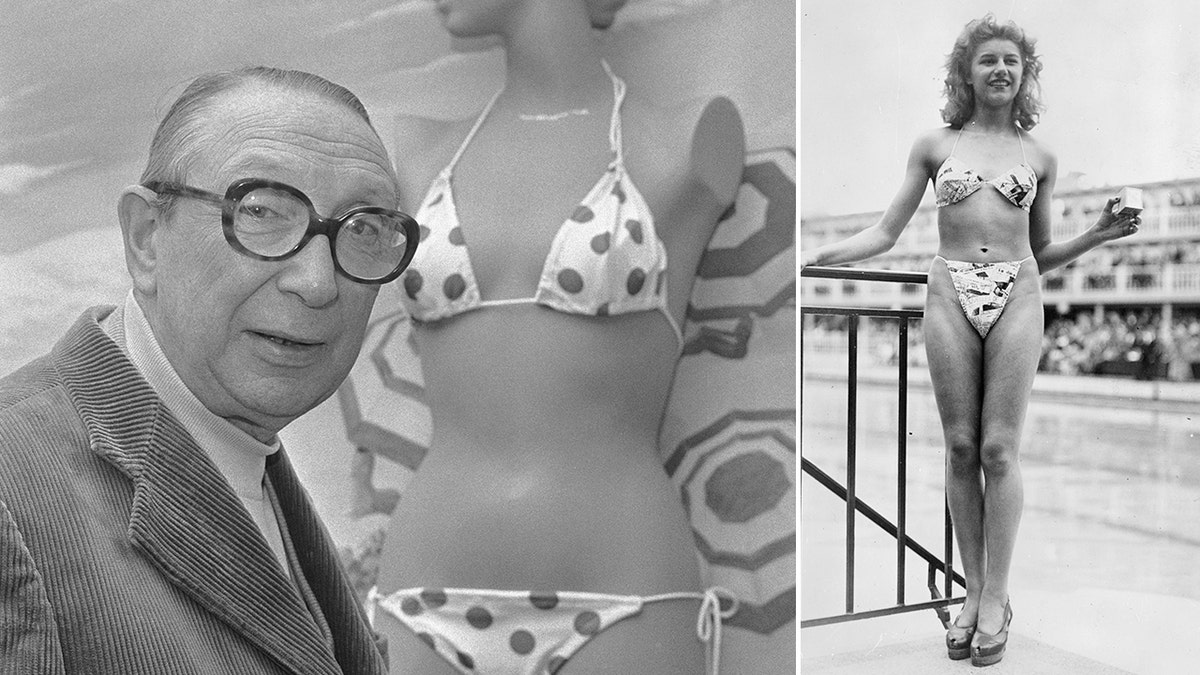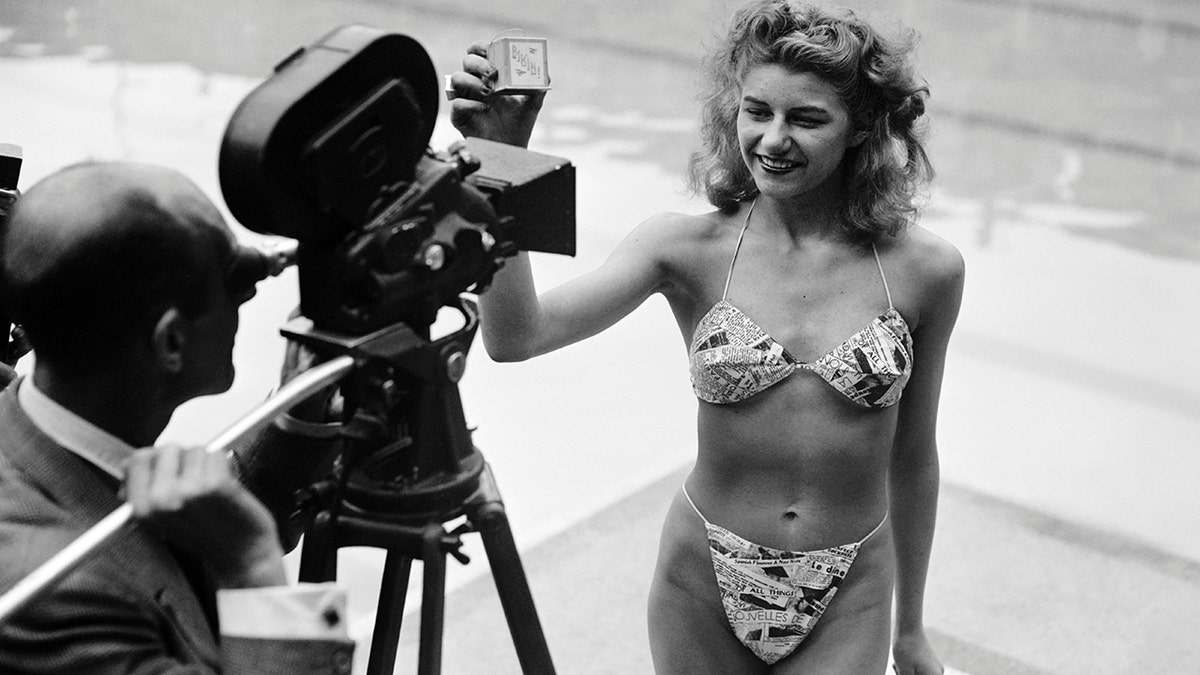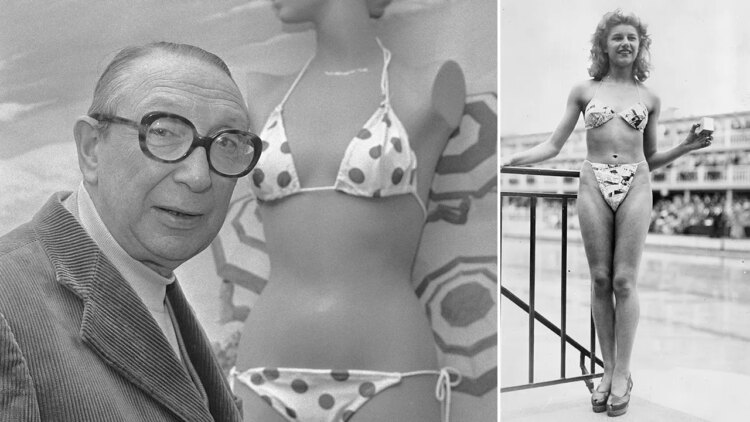The modern bare-backed bikini, though decorated with a unique tie or charm, is nearly identical to the creation of the first official risqué two-piece set from the 1940s, which turned both women and men off from the sight of it for almost two decades due to lack of conservativeness.
On July 5, 1946, 18-year-old French exotic dancer Micheline Bernardini brazenly donned the first black and white bikini of its nature during a press conference at a public swimming pool in Paris.
Louis Réard, a prestigious French mathematician-turned-clothing designer, pieced together the bikini design women have wiggled into for nearly 80 years with the intent of drawing attention. He hoped the bikini featuring newspaper clippings would strike as much shock and horror as the atomic bomb from 1945. The leaf-stopping photographs of Bernardini published on the front page of newspapers did just that.
NATIONAL BIKINI DAY: 5 THINGS YOU DIDN’T KNOW ABOUT THE SKIMPY TWO-PIECE SWIMSUIT

Louis Réard designed the first two-piece bathing suit where the bottoms cut below the navel. French exotic dancer Micheline Bernardini was hired to wear the bikini in front of journalists on July 5, 1946. (Photo by Bettmann via Getty Images | Photo by Keystone-France/Gamma-Keystone via Getty Images)
Réard hired Bernardini to saunter around in front of cameras in his G-string bottom and triangle top design when professional runway models refused to rock the next-to-nothing swimsuit.
Bernardini received around 50,000 fan letters, mostly from men, following the news coverage of the ordeal, according to History.com
The design devoid of much fabric was labeled “bikini” by Réard after the nuclear warhead test happened off the tiny island of Bikini Atoll in the Pacific Ocean earlier that week.
Though the adoration for Bernardini in 30 inches of cotton and jersey rolled in quickly, Réard’s design struggled to strike a chord with American wearers until the 1960s. In the 1950s, European women began wearing the scant bikini, though Spain and Italy banned the suit style on public beaches in the early 1950s.
The skimpiness of the bathing suit was in part due to material rationing during World War II.
SI SWIM SEARCH FINALIST KRISTEN LOUELLE GAFFNEY, MOM OF TWO, UNVEILS CURVES ON MIAMI RUNWAY: ‘MAGICAL MOMENT’

French exotic dancer Micheline Bernardini was hired when professional runway models refused to wear the scant two-piece in public. She received nearly 50,000 fan letters after photographs of her were printed. (AFP via Getty Images)
WWII placed a heavy burden on rationing of supplies across the U.S. and Britain, and restrictions on items including food, shoes and fabrics, among other supplies, were put in place to conserve.
In order to purchase items that were rationed, individuals had to both pay for food and materials, and also provide “points” at the time of purchase. Points were issued to people, including babies, in the form of blue and red stamps for a variety of selected items.
If an item was easily accessible but rationed, it cost fewer points than an item in high demand. In 1943, one pound of bacon cost 30 cents and 7 points, according to the National WWII Museum.
In terms of clothing, Britain rationed fabrics in 1941. A woman’s dress cost 11 points, and 8 points were required for a man’s shirt, according to the Imperial War Museum’s website.
The length of men’s shirts was restricted and double cuffs on collared shirts were banned altogether. Additionally, prices of clothing rose and fabrics were limited. Some textiles, including silk, were made entirely unavailable to designers and manufacturers.
SI SWIMSUIT COVER GIRL BROOKS NADER REVEALS HER SECRET TO STAYING BIKINI-READY

Nearly 80 years after the first two-piece bikini was revealed and subsequently banned on some European beaches, the swimsuit remains popular among women around the world. (Alexander Tamargo/Getty Images for Sports Illustrated)
At the time, women’s fashion was not a priority, and the selection of clothing for women was scarce. As civilians remained dedicated to fashion, they made do with what was available and affordable.
As the British and American governments continued their efforts to conserve for their nations, designers like Réard pivoted design and marketing strategies to appeal to audiences and used raw materials and resources like cotton to create stylized apparel that still met ration requirements – hence the bikini.
When WWII ended, the rationing program did, too, but the bikini stuck around.
While Réard provided the namesake, bikini drama and an audience for Bernardini, his design was not the first two-piece swimsuit available to sunbathers, though it was the first to be cut below the navel.
In 1946, fashion designer Jacques Heim, and rival to Réard, revealed what he called the “smallest bathing suit in the world” and named it Atome for its size. However, his first designs were revealed in the 1930s.
CLICK HERE TO GET THE FOX NEWS APP
Heim hoped to create the same level of excitement surrounding the itsy bitsy beach apparel as the explosion of an atomic bomb, according to the Museum of Jewish People.
Though women have appeared poolside in bikinis for nearly eight decades, the swimsuit remains a flagrant and attention-grabbing summer accessory.
(this story has not been edited by TSA Mag staff and is published from a syndicated feed.)
The modern bare-backed bikini, though decorated with a unique tie or charm, is nearly identical to the creation of the first official risqué two-piece set from the 1940s, which turned both women and men off from the sight of it for almost two decades due to lack of conservativeness.
On July 5, 1946, 18-year-old French exotic dancer Micheline Bernardini brazenly donned the first black and white bikini of its nature during a press conference at a public swimming pool in Paris.
Louis Réard, a prestigious French mathematician-turned-clothing designer, pieced together the bikini design women have wiggled into for nearly 80 years with the intent of drawing attention. He hoped the bikini featuring newspaper clippings would strike as much shock and horror as the atomic bomb from 1945. The leaf-stopping photographs of Bernardini published on the front page of newspapers did just that.
NATIONAL BIKINI DAY: 5 THINGS YOU DIDN’T KNOW ABOUT THE SKIMPY TWO-PIECE SWIMSUIT

Louis Réard designed the first two-piece bathing suit where the bottoms cut below the navel. French exotic dancer Micheline Bernardini was hired to wear the bikini in front of journalists on July 5, 1946. (Photo by Bettmann via Getty Images | Photo by Keystone-France/Gamma-Keystone via Getty Images)
Réard hired Bernardini to saunter around in front of cameras in his G-string bottom and triangle top design when professional runway models refused to rock the next-to-nothing swimsuit.
Bernardini received around 50,000 fan letters, mostly from men, following the news coverage of the ordeal, according to History.com
The design devoid of much fabric was labeled “bikini” by Réard after the nuclear warhead test happened off the tiny island of Bikini Atoll in the Pacific Ocean earlier that week.
Though the adoration for Bernardini in 30 inches of cotton and jersey rolled in quickly, Réard’s design struggled to strike a chord with American wearers until the 1960s. In the 1950s, European women began wearing the scant bikini, though Spain and Italy banned the suit style on public beaches in the early 1950s.
The skimpiness of the bathing suit was in part due to material rationing during World War II.
SI SWIM SEARCH FINALIST KRISTEN LOUELLE GAFFNEY, MOM OF TWO, UNVEILS CURVES ON MIAMI RUNWAY: ‘MAGICAL MOMENT’

French exotic dancer Micheline Bernardini was hired when professional runway models refused to wear the scant two-piece in public. She received nearly 50,000 fan letters after photographs of her were printed. (AFP via Getty Images)
WWII placed a heavy burden on rationing of supplies across the U.S. and Britain, and restrictions on items including food, shoes and fabrics, among other supplies, were put in place to conserve.
In order to purchase items that were rationed, individuals had to both pay for food and materials, and also provide “points” at the time of purchase. Points were issued to people, including babies, in the form of blue and red stamps for a variety of selected items.
If an item was easily accessible but rationed, it cost fewer points than an item in high demand. In 1943, one pound of bacon cost 30 cents and 7 points, according to the National WWII Museum.
In terms of clothing, Britain rationed fabrics in 1941. A woman’s dress cost 11 points, and 8 points were required for a man’s shirt, according to the Imperial War Museum’s website.
The length of men’s shirts was restricted and double cuffs on collared shirts were banned altogether. Additionally, prices of clothing rose and fabrics were limited. Some textiles, including silk, were made entirely unavailable to designers and manufacturers.
SI SWIMSUIT COVER GIRL BROOKS NADER REVEALS HER SECRET TO STAYING BIKINI-READY

Nearly 80 years after the first two-piece bikini was revealed and subsequently banned on some European beaches, the swimsuit remains popular among women around the world. (Alexander Tamargo/Getty Images for Sports Illustrated)
At the time, women’s fashion was not a priority, and the selection of clothing for women was scarce. As civilians remained dedicated to fashion, they made do with what was available and affordable.
As the British and American governments continued their efforts to conserve for their nations, designers like Réard pivoted design and marketing strategies to appeal to audiences and used raw materials and resources like cotton to create stylized apparel that still met ration requirements – hence the bikini.
When WWII ended, the rationing program did, too, but the bikini stuck around.
While Réard provided the namesake, bikini drama and an audience for Bernardini, his design was not the first two-piece swimsuit available to sunbathers, though it was the first to be cut below the navel.
In 1946, fashion designer Jacques Heim, and rival to Réard, revealed what he called the “smallest bathing suit in the world” and named it Atome for its size. However, his first designs were revealed in the 1930s.
CLICK HERE TO GET THE FOX NEWS APP
Heim hoped to create the same level of excitement surrounding the itsy bitsy beach apparel as the explosion of an atomic bomb, according to the Museum of Jewish People.
Though women have appeared poolside in bikinis for nearly eight decades, the swimsuit remains a flagrant and attention-grabbing summer accessory.











